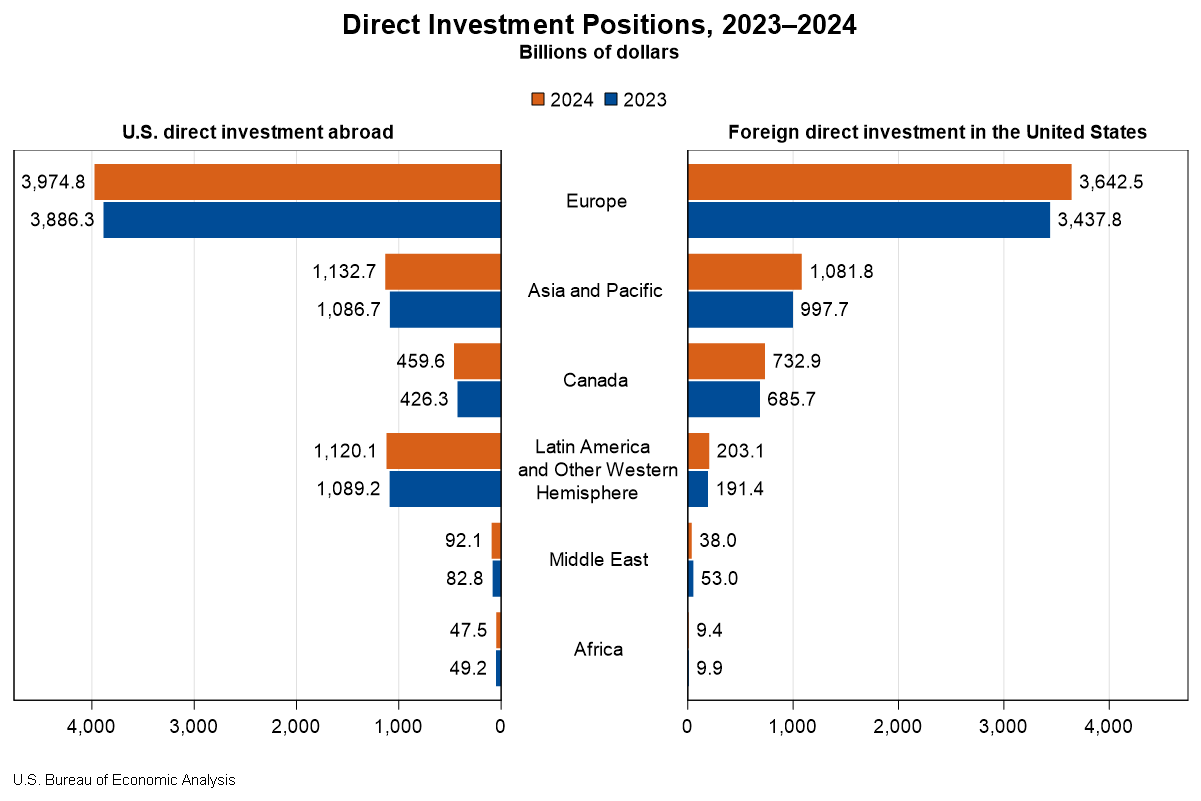Bureau of Economic Analysis
Direct Investment by Country and Industry, 2024
The U.S. direct investment abroad position, or cumulative level of investment, increased $206.3 billion to $6.83 trillion at the end of 2024, according to statistics released today by the U.S. Bureau of Economic Analysis. The increase was led by an $88.4 billion increase in the position in Europe, primarily in Luxembourg and Germany. By industry, manufacturing affiliates had the largest increase, led by manufacturing of computers and electronic products.
The foreign direct investment in the United States position increased $332.1 billion to $5.71 trillion at the end of 2024. The increase was led by a $204.7 billion increase in the position from Europe, which reflected a $52.9 billion increase from the United Kingdom and a $39.7 billion increase from Germany. By industry, affiliates in manufacturing increased the most.
Principal Federal Economic Indicators
Noteworthy
- 2025 News Release Schedule
- Innovation at BEA
- 2025 Annual Updates
- New! Services Trade Data for More Countries
- Data Tool: Trade in Value Added
- Distribution of State Personal Income
- Updated: RIMS II Regional Multipliers
- Arts and Culture
- Space Economy
- FDI Now in State BEARFACTS
- Quick Guide: Price Indexes
The Latest
U.S. Current Account Deficit Widens in 2020
The U.S. current account deficit, which reflects the combined balances on trade in goods and services and income flows between U.S. residents and residents of other countries, widened by $167.0 billion, or 34.8 percent, to $647.2 billion in 2020. The widening mostly reflected reduced surpluses on primary income and on services and an expanded deficit on goods. The 2020 deficit was 3.1 percent of current dollar gross domestic product, up from…
U.S. Current Account Deficit Widens in Fourth Quarter 2020
The U.S. current account deficit, which reflects the combined balances on trade in goods and services and income flows between U.S. residents and residents of other countries, widened by $7.6 billion, or 4.2 percent, to $188.5 billion in the fourth quarter of 2020. The widening mostly reflected an expanded deficit on goods and a reduced surplus on services that were partly offset by a reduced deficit on secondary income. The fourth quarter…
U.S. International Transactions, Fourth Quarter and Year 2020
The U.S. current account deficit widened by $7.6 billion, or 4.2 percent, to $188.5 billion in the fourth quarter of 2020, according to statistics from the U.S. Bureau of Economic Analysis. The revised third quarter deficit was $180.9 billion. The fourth quarter deficit was 3.5 percent of current dollar gross domestic product, up from 3.4 percent in the third quarter.
Input-Output Accounts: Who Sells What to Whom
At the foundation of BEA's industry statistics are the input-output accounts — a guide to the inner workings of the U.S. economy. These detailed tables can help you trace supply chains, see indirect connections between industries, or study an industry's imports and exports.
2020 Trade Gap is $681.7 Billion
The U.S. international trade deficit increased in 2020 according to the U.S. Bureau of Economic Analysis and the U.S. Census Bureau. The deficit increased from $576.9 billion in 2019 to $681.7 billion in 2020, as exports decreased more than imports. As a percentage of U.S. gross domestic product, the goods and services deficit was 3.3 percent in 2020, up from 2.7 percent in 2019. The goods deficit increased from $864.3 billion in 2019 to $915…
January 2021 Trade Gap is $68.2 Billion
The U.S. monthly international trade deficit increased in January 2021 according to the U.S. Bureau of Economic Analysis and the U.S. Census Bureau. The deficit increased from $67.0 billion in December (revised) to $68.2 billion in January, as imports increased more than exports. The previously published December deficit was $66.6 billion. The goods deficit increased $1.3 billion in January to $85.4 billion. The services surplus increased $0.…
U.S. International Trade in Goods and Services, January 2021
The U.S. monthly international trade deficit increased in January 2021 according to the U.S. Bureau of Economic Analysis and the U.S. Census Bureau. The deficit increased from $67.0 billion in December (revised) to $68.2 billion in January, as imports increased more than exports. The previously published December deficit was $66.6 billion. The goods deficit increased $1.3 billion in January to $85.4 billion. The services surplus increased $0.1…
Personal Income and Outlays, January 2021
Personal income increased 10.0 percent (monthly rate) while consumer spending increased 2.4 percent in January as provisions of the Coronavirus Response and Relief Supplemental Appropriations (CRRSA) Act enacted on December 27, 2020, began to take effect.
Personal Income and Outlays, January 2021
Personal income increased 10.0 percent (monthly rate) while consumer spending increased 2.4 percent in January as provisions of the Coronavirus Response and Relief Supplemental Appropriations (CRRSA) Act enacted on December 27, 2020, began to take effect.
Gross Domestic Product, Fourth Quarter and Year 2020
Real gross domestic product (GDP) increased at an annual rate of 4.1 percent in the fourth quarter of 2020, reflecting both the continued economic recovery from the sharp declines earlier in the year and the ongoing impact of the COVID-19 pandemic, including new restrictions and closures that took effect in some areas of the United States. The increase was 0.1 percentage point higher than the “advance” estimate released in January. In the…




